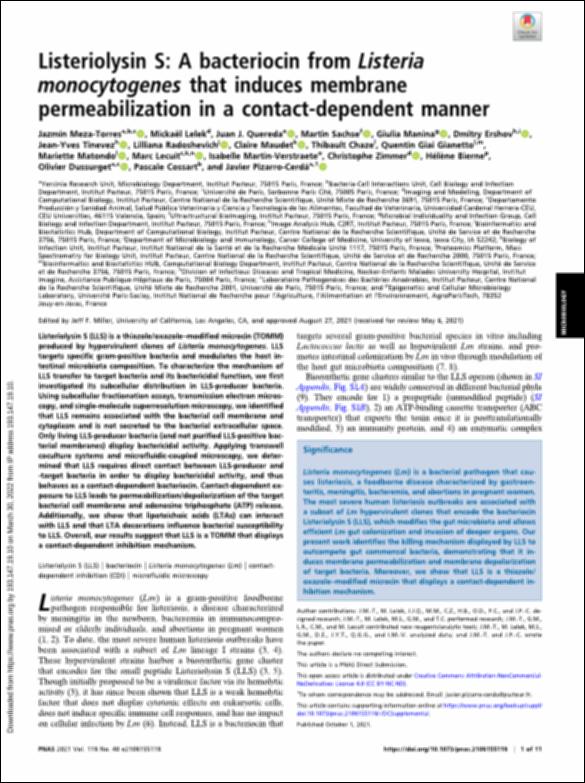Por favor, use este identificador para citar o enlazar este ítem:
http://hdl.handle.net/10637/13710Listeriolysin S : a bacteriocin from "Listeria monocytogenes" that induces membrane permeabilization in a contact-dependent manner
| Título : | Listeriolysin S : a bacteriocin from "Listeria monocytogenes" that induces membrane permeabilization in a contact-dependent manner |
| Autor : | Meza Torres, Jazmín Lelek, Mickaël Quereda Torres, Juan José Sachse, Martin Manina, Giulia Ershov, Dmitry |
| Materias: | Food poisoning.; Bacteriocinas.; Listeriolysin S (LLS); Listeriosis.; Veterinary microbiology.; Microbiología veterinaria.; Intoxicación por alimentos.; Listeria monocytogenes.; Bacteriocins. |
| Editorial : | National Academy of Science |
| Citación : | Meza-Torres, J., Lelek, M., Quereda, J.J., Sachse, M., Manina, G., Ershov, D. et al. (2021). Listeriolysin S : a bacteriocin from "Listeria monocytogenes" that induces membrane permeabilization in a contact-dependent manner. Proceedings of the National Academy of Sciences (PNAS), vol. 118, i. 40 (01 oct.), art. e2108155118. DOI: https://doi.org/10.1073/pnas.2108155118 |
| Resumen : | Listeriolysin S (LLS) is a thiazole/oxazole–modified microcin (TOMM) produced by hypervirulent clones of Listeria monocytogenes. LLS targets specific gram-positive bacteria and modulates the host intestinal microbiota composition. To characterize the mechanism of LLS transfer to target bacteria and its bactericidal function, we first investigated its subcellular distribution in LLS-producer bacteria. Using subcellular fractionation assays, transmission electron microscopy, and single-molecule superresolution microscopy,we identified that LLS remains associated with the bacterial cell membrane and cytoplasm and is not secreted to the bacterial extracellular space. Only living LLS-producer bacteria (and not purified LLS-positive bacterial membranes) display bactericidal activity. Applying transwell coculture systems and microfluidic-coupled microscopy, we determined that LLS requires direct contact between LLS-producer and -target bacteria in order to display bactericidal activity, and thus behaves as a contact-dependent bacteriocin. Contact-dependent exposure to LLS leads to permeabilization/depolarization of the target bacterial cell membrane and adenosine triphosphate (ATP) release. Additionally, we show that lipoteichoic acids (LTAs) can interact with LLS and that LTA decorations influence bacterial susceptibility to LLS. Overall, our results suggest that LLS is a TOMM that displays a contact-dependent inhibition mechanism. |
| Descripción : | Este artículo se encuentra disponible en la siguiente URL: https://www.pnas.org/doi/epdf/10.1073/pnas.2108155118 En este artículo de investigación también participan: Jean-Yves Tinevez, Lilliana Radoshevich, Claire Maudet, Thibault Chaze, Quentin Giai Gianetto, Mariette Matondo, Marc Lecuit, Isabelle Martin-Verstraete, Christophe Zimmer, Hélène Bierne, Olivier Dussurget, Pascale Cossart y Javier Pizarro-Cerdá. |
| URI : | http://hdl.handle.net/10637/13710 |
| Derechos: | http://creativecommons.org/licenses/by-nc-nd/4.0/deed.es |
| ISSN : | 0027-8424 1091-6490 (Electrónico) |
| Fecha de publicación : | 1-oct-2021 |
| Centro : | Universidad Cardenal Herrera-CEU |
| Aparece en las colecciones: | Dpto. Producción y Sanidad Animal, Salud Pública Veterinaria y Ciencia y Tecnología de los Alimentos |
Los ítems de DSpace están protegidos por copyright, con todos los derechos reservados, a menos que se indique lo contrario.


